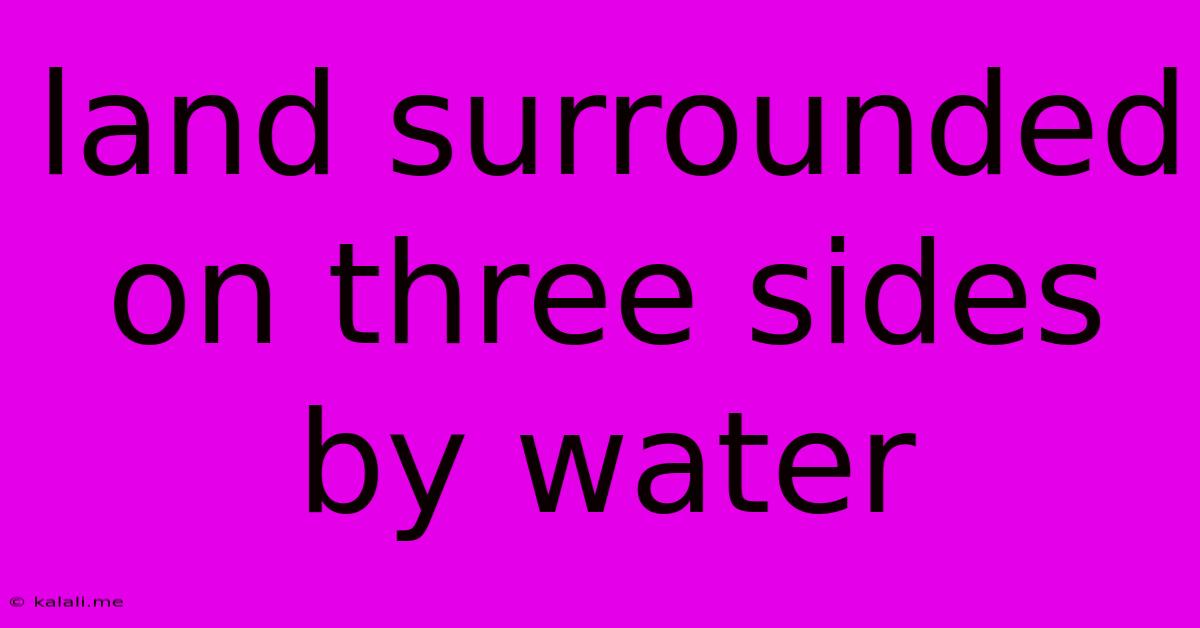Land Surrounded On Three Sides By Water
Kalali
Jun 13, 2025 · 3 min read

Table of Contents
Land Surrounded on Three Sides by Water: Exploring the Definition and Types of Peninsulas
A landform surrounded by water on three sides is commonly known as a peninsula. This geographical feature is a prominent landmass that projects outward from a larger land area, extending into a surrounding body of water. Understanding peninsulas requires exploring their diverse formations, sizes, and the unique ecosystems they support. This article will delve into the characteristics of peninsulas, differentiating them from other landforms, and examining some notable examples worldwide.
Defining a Peninsula: More Than Just Three Sides
While the simple definition points to land surrounded by water on three sides, it's crucial to understand the nuances. The defining factor isn't just the number of sides surrounded by water, but the connection to a larger landmass. A small island completely surrounded by water wouldn't qualify as a peninsula, regardless of its size. The key is the continental connection, a relatively narrow isthmus or neck of land linking the peninsula to the mainland. This connection is often crucial for the peninsula’s ecological integrity and human settlements. The size can also vary greatly; from small, barely noticeable stretches of land to massive landforms stretching hundreds of kilometers.
Formation of Peninsulas: A Geological Perspective
Peninsulas are formed through various geological processes, making each one unique. Some common formations include:
- Tectonic Activity: The movement of tectonic plates can create peninsulas by uplifting land or causing the land to separate from the larger landmass. This is often seen in areas with high seismic activity.
- Deposition: The accumulation of sediments, carried by rivers or ocean currents, can gradually build up land, extending outwards into the water and creating a peninsula. This process typically occurs over long periods.
- Volcanic Activity: Volcanic eruptions can create landmasses extending into the water, forming volcanic peninsulas. The solidified lava and volcanic rock form the peninsula’s structure.
- Erosion: Erosion of coastal areas can create peninsulas by selectively wearing away land, leaving a protruding section. This is often seen in areas with softer rock formations.
Types and Examples of Peninsulas
Peninsulas come in various shapes and sizes, and understanding the differences can help appreciate their geological diversity:
- Large Peninsulas: The Iberian Peninsula (Spain and Portugal), the Arabian Peninsula, and the Korean Peninsula are prime examples of massive peninsulas, supporting diverse ecosystems and large populations.
- Small Peninsulas: Many smaller peninsulas exist along coastlines worldwide, often playing important roles in local economies and ecosystems.
- Mountainous Peninsulas: Peninsulas like the Baja California Peninsula are characterized by mountainous terrain, creating unique biodiversity and challenging landscapes.
- Coastal Peninsulas: Coastal peninsulas are often characterized by flat, sandy, or rocky shores, with a more temperate climate due to their proximity to the ocean.
Ecological Significance and Human Impact
Peninsulas often exhibit unique ecosystems due to their location and geographical characteristics. The presence of both land and water creates a diverse habitat supporting a range of plant and animal life. However, human activities, including urbanization, agriculture, and tourism, can negatively impact these sensitive environments. Coastal erosion, pollution, and habitat destruction are critical concerns for the preservation of peninsular ecosystems. Sustainable management and conservation efforts are crucial to protecting the biodiversity and resources of peninsulas worldwide.
In conclusion, a peninsula, while simply defined as land surrounded by water on three sides, presents a complex and fascinating geographical feature. Understanding its geological formation, diverse types, and ecological significance is crucial for appreciating the beauty and importance of these landforms. Furthermore, recognizing the impact of human activities on peninsular environments highlights the need for responsible stewardship of these unique and often fragile ecosystems.
Latest Posts
Latest Posts
-
What Are The Units Of Emf
Jun 14, 2025
-
What Is The Lcm Of 3 4 And 8
Jun 14, 2025
-
Eulers Theorem On Homogeneous Functions Examples
Jun 14, 2025
-
Transient Response Of An Rc Circuit
Jun 14, 2025
-
Which Is The Angle Of Elevation From B To A
Jun 14, 2025
Related Post
Thank you for visiting our website which covers about Land Surrounded On Three Sides By Water . We hope the information provided has been useful to you. Feel free to contact us if you have any questions or need further assistance. See you next time and don't miss to bookmark.